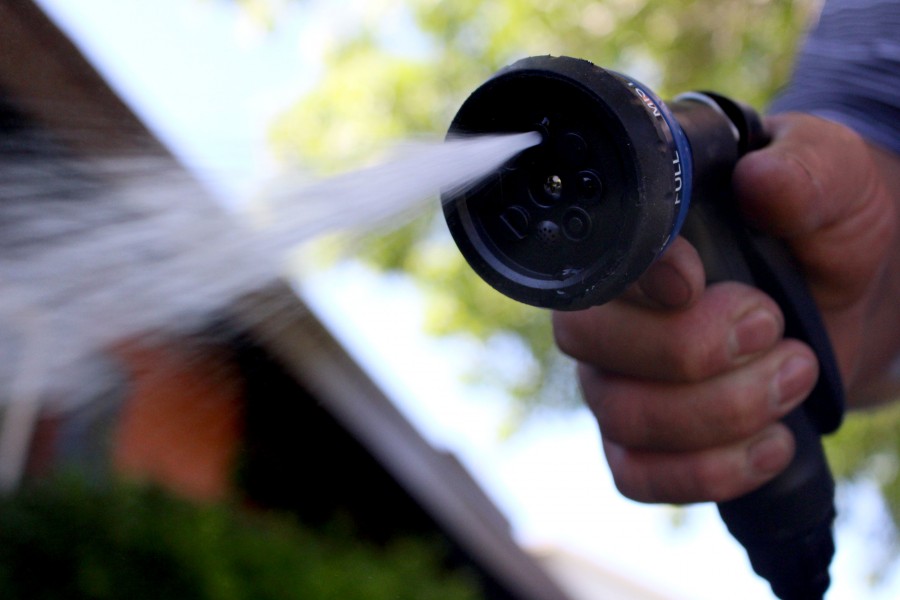Josiah Heyman, professor of sociology and anthropology, and William Hargrove, director of the Center for Environmental Resource Management, come from two very different backgrounds, but they are united not only by the five year, multi-institution $4.9 million grant they secured, but by a common goal–to find solutions for dwindling water supplies as a result of climate change in the El Paso Del Norte region.
The grant was given by the National Institute of Food and Agriculture to UTEP, along with New Mexico State University, Texas A&M-El Paso, The University of New Mexico, Michigan Tech and Universidad Autonoma de Ciudad Juárez and will be administered by Heyman and Hargrove.
“These are some of the realities that people are beginning to experience,” Hargrove said when talking about a recent drought in El Paso and about residents from Vinton, a small incorporated town outside of El Paso city, who did not have water due to a water shortage. “Climate change is not out there somewhere, it’s happening now.”
Javier Camacho, public information’s officer for El Paso Water Utilities, said the city has been in a drought for more than two decades and has seen extreme low levels of water from the Rio Grande River and Elephant Butte, a federal reservoir managed by Bureau of Reclamation Department of Interior, resulting in increased water use from two aquifers, the Mesilla Bolson and the Hueco Bolson.
“Having more than one water source means that EPWU can shift between them when one is not available to meet water demands,” said Christina Montoya, communications and marketing manager for El Paso Water Utilities.
Heyman said efforts by EPWU to conserve water have resulted in the city having one of the lowest water-per-person user rates. El Paso’s neighbor city of Cd. Juárez is also mindful in its administration of water.
“Contrary to popular belief, Juárez is one of the cities with the best efficacy in its administering of water in the country,” said Alfredo Granados Olivas, water specialist at the Universidad Autónoma de Ciudad Juárez, and one of the scientists involved in the grant. “The community is very conscious of water disposability and the authorities are always implementing programs.”
Yet, despite these efforts, the cities are not immune to the effects of climate change and both Granados and Heyman agree that work needs to be done in both cities.
“We can definitely tell that it hasn’t been enough,” Heyman said. “The way we can tell that it’s not enough is that the level of the underground water has been going down over time.”
According to the Environmental Protection Agency, further warming in the southwest region of the U.S. is expected to produce more severe droughts in the region, which is expected to further decrease water. Existing droughts have caused increased use of aquifers, or underground water, and decreased water tables.
The team of researchers and scientists aim to find solutions to expected water shortages, albeit in a different manner.
Traditionally, projects like the ones they are addressing have had a scientifically led approach, however this one will have a participatory approach—what Heyman calls a “democratically oriented kind of science.”
“Our job is to not to lay out our vision of the future, but stakeholders’ vision of the future,” said Frank Ward, professor of water economics and policy at New Mexico State University, and one of the researchers involved in the grant.
Stakeholders are users of water–farmers, the commercial and industrial sectors and environmental interest groups. Through this approach, scientists are constantly engaged with stakeholders, as they are the center of the project and will define the questions and propose solutions.
“They understand better what the situation is and are learning themselves more about what the future holds for water,” Hargrove said. “Scientist-driven research hasn’t resulted in change. We think that this kind of approach, where the stakeholders are involved–there’s a better chance for change.”
The participatory approach is not new, but it’s not common. Hargrove has experience with the approach. He worked with a scientific team that used this method to work with farmers in Kansas to improve water quality.
The first thing they did was to analyze the water to find where the pollution was coming from, and then they approached the farmers to find solutions.
“When they would make suggestions or come up with ideas about management practices that they could implement, we would test those in our model,” Hargrove said. “It was very successful and in the end, farmers did implement a number of practices to improve the water quality.”
This approach is similar to what UTEP and the other institutions working within the grant will do.
The scientific aspect involves using computer models that simulate the hydrology of the region. These models will be used in the stakeholder approach by measuring existing conditions and measuring how effective potential solutions can be.
“It’s not only predictive in the sense that it’s going to give you one fixed definite answer, but in the sense that it allows you to explore different options,” Heyman said. “This is a way of talking about different possible futures.”
After the stakeholders propose solutions, policies or practices, they will be tested or measured in the models. In the end what they hope to accomplish is finding something that works.
“What I would like to see is that each of these different sectors is going to have some practices or some change that they can make that is going to enable us to have a sustainable future,” Hargrove said.
Another aspect that’s different from the grant is the binational aspect.
According to Olivas, the interesting part of the grant is that they are studying the hydrological aspects of the region without the limitations of borders.
“In the concept of hydrology, this is very important because you’re not dividing the region by imaginary lines,” Olivas said.
But the Rio Grande is a border and its water is divided. In 1906, President Theodore Roosevelt signed the Equitable Distribution of Waters of the Rio Grande, establishing an agreement between the U.S. and Mexico to deliver 60,000 acre feet of water per year from the Rio Grand for the purposes of water irrigation.
However, the agreement does not say anything about underground water.
“Transboundary sub-surface water is one the truly important issues of the contemporary world and we have no system for handling that right now, we barely have a system for knowing what’s there,” Heyman said.
Granados said that underground water systems are very complex and it would take a lot of research before arriving at an underground water treaty. He also said that the objective of the grant is not a binational treaty for underground water.
“We want the best information that has been validated by science–to inform society. An informed society is a successful society that can make decisions in conjunction with the government,” Granados said.
One of the great challenges of the project will be to get the scientists, stakeholders, policy makers and industries on the same page.
That is why, according to Hargrove, participatory approaches are not popular. However, all the institutions are looking to accomplish the same thing–to make a change.
“The common goal is for each of these institutions to contribute their specialized expertise that would give a rise to sustainable water use,” Ward said. “We want to find the best way in the region for adapting to the new normal of greatly reduced water.”
Maria Esquinca may be reached at [email protected].









